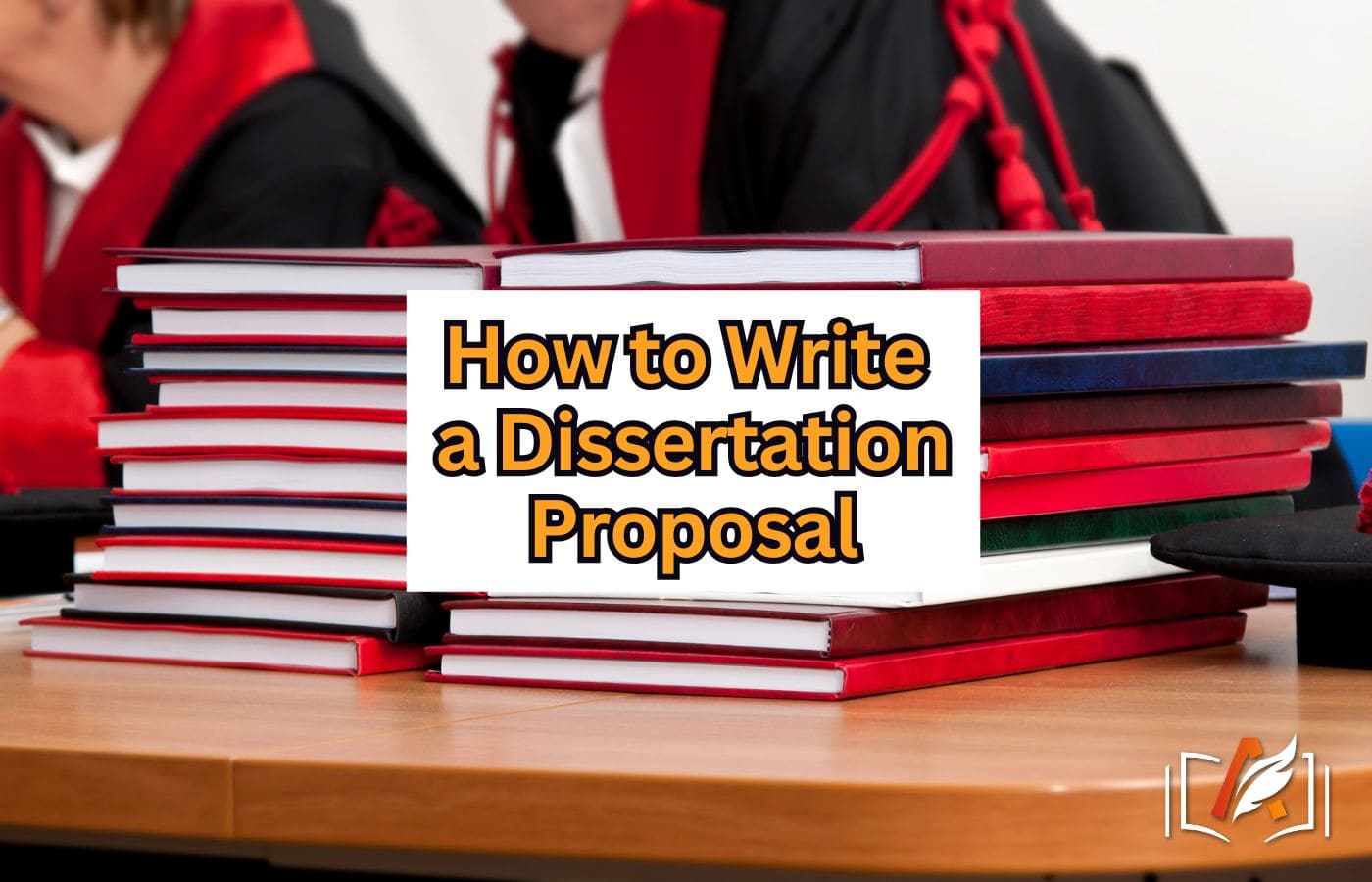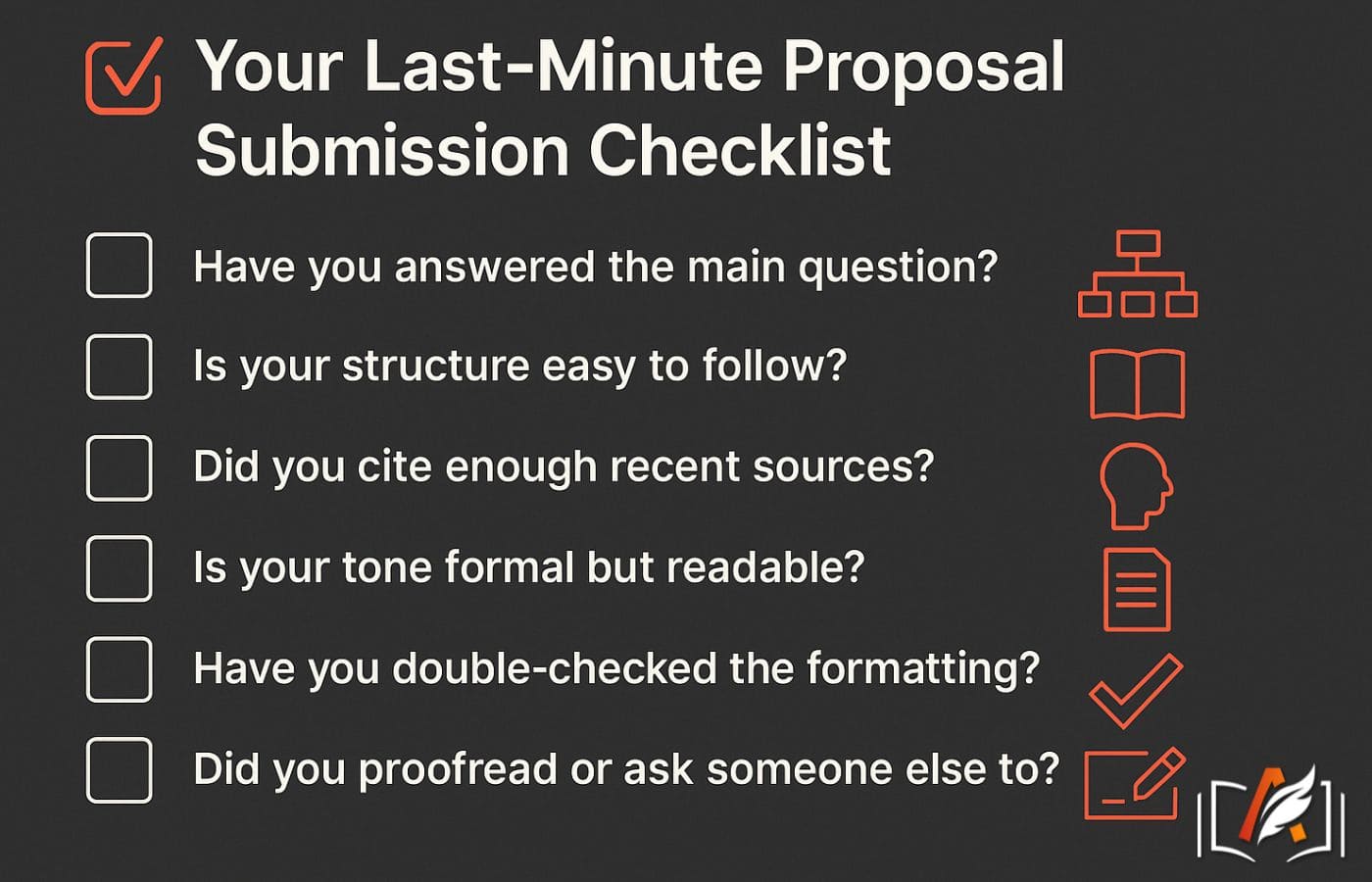 Ruby Butz
Ruby Butz

Writing a dissertation proposal means laying out a clear path for your research journey. It shows what you’ll explore, why it’s essential, and how you plan to do it. A solid proposal proves your idea is focused, achievable, and supported by relevant sources. Think of it as your research game plan – it keeps you on track and lets others see your academic vision.
From our experience as academic writing professionals, we understand that the early stages can feel intimidating. That’s why knowing how to write a dissertation proposal matters. It’s not about making it perfect from the start – it’s about creating something structured and goal-driven. Whether you're writing at the undergraduate, master's, or PhD level, having a straightforward question and a practical plan makes the whole process smoother. Let’s break down what works and why.
Explaining the Dissertation Proposal
A dissertation proposal is a short but detailed plan for your future research. It outlines your topic, research question, and methodology, helping your advisor or committee understand what you aim to study and why it matters. Most universities require this formal plan before allowing students to begin writing the whole dissertation.
This proposal gives structure to your ideas, shows that your project is doable, and helps set expectations early. You’re not just explaining what you want to explore, you’re also showing how you plan to do it.
The Importance of a Strong Proposal
Getting the proposal right can make your dissertation easier down the road. It acts like a map, keeping your research focused and writing clear. Reviewers use it to judge whether your study has value, whether your topic is specific enough, and whether your planned approach fits the goals of your field.
A solid proposal can prevent future rewrites or wasted time. With a well-developed plan, you can start gathering data or building arguments confidently, knowing you’ve already earned support from your supervisor.
Expert writing support can ease the pressure if you struggle to organise your thoughts or meet deadlines. If you wonder who can write my dissertation in a week, State of Writing is a trusted option when time is short and academic standards remain high. Getting guidance early can save time and boost clarity, whether it's your dissertation proposal abstract or overall structure.
Topic Ideas That Matter Now
Topic selection is where many students get stuck. It’s tempting to pick something broad or safe, but successful proposals usually start with a focused idea related to ongoing conversations in your field. Currently, trends often involve digital innovation, global change, and social equity. Here are 10 dissertation proposal topic ideas that are both relevant and manageable:
- The Impact of Artificial Intelligence on Workplace Productivity in Small Businesses
- How Climate Change Policies Affect Rural Communities in Developing Countries
- TikTok and Teen Identity: A Study of Algorithmic Influence on Self-Image
- Exploring the Ethics of AI-Generated Art in Professional Design Industries
- Remote Learning Outcomes in Post-Pandemic Higher Education
- The Rise of Digital Currencies and Their Effect on National Financial Systems
- Gender Bias in Hiring Algorithms Used by HR Tech Platforms
- How Urban Green Spaces Contribute to Mental Well-Being in Large Cities
- The Role of Social Media in Political Mobilisation Among Gen Z Voters
- Assessing the Success of Corporate Sustainability Initiatives in the Fashion Industry
Mastering the Dissertation Proposal Process
Writing a dissertation proposal is the first step toward completing your final project. It outlines what you plan to study, how you'll do it, and why it matters. Getting this part right builds a strong foundation for your entire dissertation. Here are the steps to write a dissertation proposal:
1. Know What Your University Expects
Every academic institution has its own formatting rules, structural preferences, and submission requirements. Reviewing your university’s handbook or online guidance helps avoid confusion later. Pay attention to page limits, citation styles, and required components such as abstracts or chapter outlines. These rules set the tone for everything that follows.
2. Shape a Clear Research Question
At the heart of every excellent proposal is a focused question. Rather than tackling a broad theme, narrow it to something specific and answerable. A well-framed question gives your project direction and helps you stay on track. It also makes your topic more appealing to supervisors and reviewers.
3. Explore Existing Scholarship
Before outlining your contribution, it’s essential to go beyond skimming – study recent journals, academic books, and reliable sources related to your topic. This research helps you spot gaps, patterns, or ongoing debates in the field. One of the most overlooked dissertation proposal writing tips is doing this groundwork early. It proves you've done your homework and that your proposal builds on a solid academic foundation.
4. Map Out How You’ll Investigate
Explaining how you plan to explore your topic is crucial. Will you conduct interviews, analyse statistics, or evaluate archival texts? Whether your approach is qualitative, quantitative, or mixed, justify your choice. Back up your plan with relevant research tools like case studies or software.
5. Think Through the Ethics
If your project involves people, even indirectly, consider the ethical implications. Protecting privacy, gaining consent, and avoiding bias are all key. Universities often require an ethics form – get familiar with it early. Even desk-based research must show awareness of responsible conduct.
6. Set Your Goals and Purpose
Rather than vague ambitions, lay out concrete aims and measurable dissertation proposal objectives. What do you hope to prove, discover, or understand? Make sure these match your question and method. This section reassures your advisor that you’ve planned your work with intention and focus.
7. Build a Practical Timeline
Without a timeline, it’s easy to fall behind. Sketch a realistic breakdown of your tasks, such as reading, writing, and collecting data, and match each with a deadline. Use calendar tools or project trackers to keep progress visible.
A solid schedule also strengthens your proposal's credibility.
8. Bring Your Ideas Together in a Draft
Now that your foundation is built, it’s time to combine the pieces. Start with a simple outline and gradually develop each section. Don’t aim for perfection – focus on getting your ideas down clearly. You’ll improve clarity and flow during editing.
9. Polish and Perfect
Editing is more than fixing typos. Read your draft aloud to catch awkward phrasing, ask for feedback, and tighten arguments. Ensure everything connects to your question and follows your school’s format. A clean, well-revised proposal leaves a lasting impression.
If you need extra help, StateOfWriting’s dissertation proposal services are here to guide you. From refining structure to ensuring clarity and flow, our experts help your proposal confidently meet academic standards.
What Every Strong Dissertation Proposal Should Include
Every successful dissertation proposal follows a logical structure. Below is a breakdown of the essential elements that make up a clear and compelling dissertation proposal outline:
- Clear Introduction: Begin with a brief overview of your topic. This section sets the stage and gives readers a sense of what area you’ll be investigating.
- Statement of the Problem: Define the issue your research addresses. Is there a gap in the literature? Is something misunderstood, under-researched, or in need of improvement?
- Research Question: Your main research question should be specific and focused. It must directly reflect the problem you’ve identified and guide the rest of your study.
- Proposed Methodology: Describe how you plan to gather and analyse data. Justify your chosen method and explain why it suits your research question.
- Significance of the Study: Explain what your work will contribute. Will it offer a new solution, a fresh perspective, or a clearer understanding of a complex issue?
- Dissertation Proposal Timeline: Present a realistic schedule for each stage of your project. Include planning, research, writing, and review phases.
- Preliminary Bibliography: Include a short list of sources you’ve already consulted. This shows you’ve started your research and understand the existing conversation.
If you’re feeling unsure about how to structure your proposal or meet tight deadlines, professional help can make a big difference. Many students buy plagiarism-free dissertation support to ensure their work is original, well-organised, and ready for supervisor review. It’s a smart way to stay on track without sacrificing academic integrity.
Smart Moves for Writing a Winning Proposal
Success starts with the right approach. Instead of rushing in, take time to prepare and think critically about your topic and structure. The tips below can guide you through how to write a good dissertation proposal:
- Read the university guidelines first. Every department has different formatting, structure, and length requirements. Knowing these early saves time and reduces revision work later.
- Choose a topic that’s narrow and clear. A tightly defined subject helps you build a focused argument. Broad ideas often lead to vague questions and unclear objectives.
- Outline before you write. Sketching a structure helps organise your thoughts and spot weak spots before drafting paragraphs.
- Use a confident, readable tone. Avoid overly technical language. The goal is to be clear and persuasive, not confusing. Strong writing is straightforward, not showy.
- Connect to existing research. Show how your project fills a gap or adds something new. Don’t just summarise the literature – demonstrate where your work fits in.
- Proofread more than once. Minor spelling, grammar, or formatting errors can weaken the best ideas. A clean draft shows you take the process seriously.
Read also: How to Write an Acknowledgement for Your Dissertation
Avoiding the Usual Dissertation Proposal Errors
Strong proposals come from a clear dissertation proposal structure and attention to detail. Yet many students make the same avoidable mistakes during this early stage of academic research.
- Choosing a broad or unfocused topic: A topic that's too general lacks direction. Narrowing your focus helps define your research question and keeps your writing on track.
- Focusing too much on background information: While context matters, your proposal should highlight what you plan to study, not just what others have said. Keep summaries brief and emphasise your own research goals.
- Failing to explain your methodology: Leaving out methods or not justifying them weakens your proposal. Reviewers expect a clear dissertation proposal methodology section that explains how you'll answer your research question and why your chosen approach fits the topic. A solid explanation builds trust in your plan and shows you’re ready to do so.
- Using too few or outdated sources: A limited or old reference list suggests weak preparation. Include recent, peer-reviewed studies to show your understanding of the current academic conversation.
- Ignoring formatting and university rules: Every institution has a specific structure, citations, and submission guidelines. Missing these can lead to unnecessary delays or rejections.
- Missing internal deadlines: Falling behind on required drafts or approvals can impact your overall timeline. Build in time for review and feedback to avoid last-minute stress.
Sample Snapshot of a Proposal That Works
A dissertation proposal example clearly shows structure, tone, and content that meet academic expectations.
Title: The Impact of Social Media Algorithms on Teen Mental Health
Introduction: This proposal explores how platforms like TikTok and Instagram influence adolescent well-being through content curation. The study focuses on self-image, emotional health, and screen-time behaviour.
Research Question: How do algorithm-driven content feeds affect mental health in teens aged 13–18?
Methodology: A mixed-methods approach will include surveys, interviews, and a short-term content analysis of participants' social media feeds.
Significance: Results may support better content regulation policies and provide insights for educators and mental health professionals.
Timeline: Six months from approval to completion, including data collection, analysis, and final write-up.
References: A preliminary list includes peer-reviewed psychology and media studies journals, plus recent health reports from credible institutions.
Spotting the Difference Between Undergraduate, Postgraduate and PhD Proposals
While all dissertation proposals aim to outline your planned research, the expectations change depending on your academic level. Each stage comes with a different depth, structure, and independence level.
Undergraduate proposals are shorter and more straightforward. These usually introduce a simple question, briefly touch on sources, and suggest a basic method. The goal is to show you understand how to shape a research project, even on a small scale.
Postgraduate-level proposals require more detail. You’ll need to show awareness of current debates, back your topic with recent literature, and explain your methodology more precisely. Demonstrating originality starts to matter more here.
PhD proposals must reflect a profound academic contribution. It involves identifying a clear research gap, offering a focused question, and outlining a method that proves you’ve thought critically about feasibility and scope. Your proposal becomes the foundation for years of original research, so it needs to show deep understanding and potential.
While the structure remains similar across academic levels, the expectations behind each dissertation proposal conclusion vary. Undergraduate proposals aim to show basic research planning, while postgraduate ones demand more critical engagement and clarity. At the PhD level, the conclusion must reflect a deep understanding of the topic’s complexity and outline the potential for original academic contribution.
Read also: How to Write a Methodology for a Dissertation
What Makes a Proposal Stand Out to a Supervisor
Impressing a supervisor isn’t about fancy words but focus, logic, and thought. A strong proposal shows you’ve considered why your topic matters, how you plan to explore it, and what makes your idea unique.
Clarity in your dissertation proposal research question is key. It raises concerns about your planning if it's vague or too broad. A well-written literature section shows that you’ve done your homework. Supervisors want to see that you’re not just repeating others’ work, but building on it.
Good structure, clear aims, and practical methods help your proposal feel grounded. Supervisors aren’t expecting perfection but looking for effort, relevance, and a clear sense of purpose.

Your Last-Minute Proposal Submission Checklist
Before submitting, it’s worth running through a quick checklist to make sure everything’s in place. When figuring out how to write a proposal for dissertation success, double-check these essentials:
- Have you answered the main question? → Ensure your topic, research aim, and method are easy to understand.
- Is your structure easy to follow? → A logical flow from background to question, method, and timeline helps the reader stay engaged.
- Did you cite enough recent sources? → Use a mix of up-to-date and foundational texts to show balance and awareness.
- Is your tone formal but readable? → Avoid jargon and keep the language professional but clear.
- Have you double-checked the formatting? → Follow your university’s guidelines to the letter – don’t lose marks for technicalities.
- Did you proofread or ask someone else to? → Catching minor errors before submission can significantly affect how your work is received.
Read also: Vital Tips on How to Write a Dissertation Introduction
Lessons Learned from Writing My Proposal
Writing my dissertation proposal in grad school felt like a mix of pressure and possibility. I clearly remember sitting in front of a blank screen, second-guessing whether my topic was too ambitious or not focused enough. It was overwhelming at first.
Approaching it step by step made a real difference. I stopped worrying about perfection and treated my first draft like a working sketch. Reading a few strong proposals helped set expectations, but what truly unlocked my progress was meeting with my supervisor early. That conversation gave me clarity, direction, and a sense that I didn’t have to figure it all out alone.
If you're unsure where to begin, this article offers clear dissertation proposal guidance every step of the way. We’ve covered everything – from selecting a topic to polishing your final draft. Along the way, you’ll find tips on what to focus on, what to leave out, and how to meet your supervisor’s expectations. Whether you're writing for undergraduate, master's, or PhD level, this breakdown is designed to help you plan and write confidently.
Frequently Asked Questions About Dissertation Proposals
What’s the best way to prepare to defend your proposal?
Focus on knowing your topic inside and out. Be ready to explain your research aim, justify your method, and show how your work fits existing studies.
How should a dissertation proposal be formatted?
Follow your department’s structure. Usually, that includes a title page, abstract, dissertation proposal introduction, literature review, methodology, timeline, and references.
Any tips for starting a dissertation proposal?
Try opening with a short, clear sentence that explains what your research is about. Example:
This project investigates how climate change policies influence farming practices in Southeast Asia.
What’s a good way to wrap up a dissertation proposal?
Conclude with a summary of your main goal and expected outcomes. Example:
This research will provide insight into regional policy effects and help shape future environmental strategies.
How long is a typical dissertation proposal?
Length varies, but most fall between 1,500 and 3,000 words, depending on your degree level and subject requirements. Always check your university’s guidelines.

Meet Ruby Butz, the accomplished author at the StateOfWriting educational blog. With a Master’s in English Literature, notable articles, and extensive teaching experience, she has helped thousands of students develop strong writing skills.
Writers are verified and tested to comply with quality standards.
Work is completed in time and delivered before deadline.
Wide range of subjects and topics of any difficulty covered.
Client id #: 000412
Paper type: Research paperI just wanted to say thank you for the collaboration. You saved me from having to retake modules. The semester is finally coming to an end - just one more month to go, then it’s time to rest. See you next academic year
Client id #: 000411
Paper type: Thesis paperprofessional service on all fronts. my 10-day order was completed in just 6 days, giving me extra time to prepare for submission. very satisfied
Client id #: 000410
Paper type: CourseworkAll was completed just as I wanted. Excellent support - Big thanks to all of you 🙏🤗